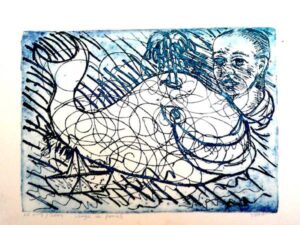Engraving or stamping
The engraving or print is a very old graphic work, where an illustration previously made on a plate is stamped on the support, usually paper. The plate is usually engraved with incisions, like a lithograph or silkscreen. In screen printing, incisions are not used, but a matrix with the illustration that seeks to be captured.
The engravings of the collection
The engravings in the art collection are scarce and differ in techniques and time taken.
Some of Antonio García Calvente’s plates are still preserved, even so, all the engravings were made by the same artist in his painting studio. His choice in this style of art was to make specific prints and later break the plates. He normally made series of between 25 and 100 prints of 4 or 5 colors from each plate.
Most were sold during the artist’s lifetime, so very few remain in the collection of art for sale.
They are unique pieces with serial number, date and signature of the author.
As can be seen in the images, series of the same plate generate unique images, the amount of color, the pressure and the humidity of the paper, make it possible to play with the final result.
Antonio’s engravings









engraving techniques
Etching
Etching is a direct engraving technique. Normally the plate is covered with a varnish and later with a tip the composition is drawn.
Subsequently, the plate is introduced into an acid, which is usually etching and hence the name, which “bites” the areas that have been marked and do not have varnish. When removing the varnish, the lines are engraved.
These cracks generated by the etching will be more or less marked according to the artist’s desire. It is also possible to carry out more or less baths, generating depths in the plate.
The mixture of the plate between acid cracks and engravings is the result of the artist’s originality.
Finally, the grooves are inked and the surface is cleaned to finally stamp them with a press on damp paper.
Aquatint
In this indirect hollow engraving technique, different shades of the color to be used are sought. After putting the resin, the iron is heated adhering it to it. Then it is introduced into the acid and the slits are generated in the resin grains according to its thickness.
This technique is usually mixed with the etching system.
Burin
The hollow engraving burin technique is engraved directly on the metal plate with a burin, detaching threads from the metal of the plate, and leaving grooves. Subsequently, the plate is inked and placed in a press on a damp paper.
It is also a technique that is usually mixed with etching or hollow point.
Dry etching
Dry engraving or embossing is a technique where an engraved plate is stamped without inking. Normally it is used in designs, marking a paper or a support with a determined surface. This technique combines the different techniques to mark the plate to the taste of the artist.
Lithography
Lithography is a planographic technique, no incision is used, and it is based on illustrations created with water and fat, which repel each other, generating a contrast of intense colors. The stamping is done on a porous stone, moistening it with fresh paint and capturing the illustration with the lithographic press on the final paper or canvas.
Linography
Linoleum plates are used in linography. It is a material made up of linseed oil and wood dust. Also cork on a jute framework. Gouges and blades are used and thus the relief of the drawing that is intended to be achieved is made.



